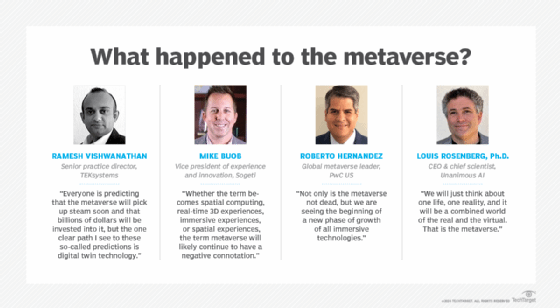Is the metaverse dead? Here's what happened and what's next
What happened to the metaverse? It's still here, even if the term no longer generates much enthusiasm, and finding useful applications across industries.
The metaverse was a white-hot topic only a few years ago. Facebook's rebranding to Meta, enthusiasm in the crypto community, and increasingly better virtual reality (VR) and extended reality (XR) headsets spurred interest in the tech. Enterprises were excited about industrial metaverse applications such as more immersive training and digital twins.
But recently, the buzz about the metaverse, or at least about the term, has died down. There are numerous causes, including Meta's slow progress, a crash in the non-fungible token (NFT) market, and Apple's positioning of the term spatial computing to replace metaverse, VR, and XR.
Is the metaverse dead?
Despite these headwinds, many industry insiders believe the metaverse is not dead -- it's just rebranding itself atop a slower-growing but more solid foundation.
Louis Rosenberg, Ph.D., CEO and chief scientist at Unanimous AI, is among those who state categorically that the metaverse is not only not dead, it's actually "hot right now."
"The only thing that changed is the language used to describe our immersive future," Rosenberg said.
Rosenburg does not come to this conclusion lightly. He has been working toward a vision of immersive computing since 1991, when he was developing one of the first mixed reality systems at Stanford and the U.S. Air Force. At the time, he expected widespread deployment of an augmented world within 10 to 15 years.
"It's now been thirty-three years, and we're at least five years from large-scale deployment," he said. But he believes the metaverse is now in sight. It will be the real world augmented with mixed reality content that seems so authentic and well-integrated into our perceptual framework that it will be perceived as just another part of our reality.
He predicts we will not be talking about our digital lives and our physical lives as separate things. "We will just think about one life, one reality, and it will be a combined world of the real and the virtual," he said. "That is the metaverse."
Roberto Hernandez, global metaverse leader and customer strategy and experience leader at PwC US, also believes that the reports of the metaverse's demise are not only premature but misguided. "I see some similarities between the people that mention that the metaverse has failed and those that back in the year 2000 were calling the internet 'a passing fad,'" he said. "Not only is the metaverse not dead, but we are seeing the beginning of a new phase of growth of all immersive technologies."

Metaverse hype cycle: A pandemic-fueled rise followed by retreat
While the claims that the metaverse is dead might be an overexaggeration, it is certainly the case that the metaverse is not being used in everyday life as originally envisioned, ventured Ramesh Vishwanathan, senior practice director at TEKsystems.
"As with most innovations, the metaverse is living its journey through the typical hype cycle," he said. At the apex of the hype, metaverse enthusiasts touted a parallel world with virtual reality deeded by NFTs, comfortable VR gear, and a fully interconnected, singular virtual world. Now, with the initial inflated expectations fading away, enterprises are starting to see some of the real-world metaverse applications come to life on multiple fronts, in retail, healthcare, architecture, and design among other areas, Vishwanathan said.
Dr. Chris Mattmann, chief technology and innovation officer at NASA Jet Propulsion Laboratory, pointed out that a worldwide epidemic contributed to the hype. The original lofty goal that everyone would be inside the metaverse, have a headset, and use NFTs and digital currency to pay for experiences flourished during a time when we all had to stay home. Once we emerged from the pandemic world, we increasingly craved in-person experiences and being together again, he said, and as a result, the metaverse lost some of its appeal. It also didn't help that the graphics in the metaverse looked like old cartoons -- and unrealistic, he added, but the concept is not dead. "There has been some love lost, but the metaverse is still here and just restructuring."
Mattmann said the focus now is on mixed reality devices and providing connections for those who want to meet with one another but are too far away and unwilling to travel. He's recently seen an uptick in metaverse technologies used for workplace meetings and productivity as an alternative to Zoom and Microsoft Teams. People looking for more realistic, in-person-like meeting experiences are using services like Spatial, Glue and Meta's Horizons Workrooms.

Why did the term metaverse lose its luster?
Parul Trivedi, practice director at the advisory firm Everest Group, said the vision of a fully immersive, universally adopted virtual realm where users interact seamlessly in virtual and augmented realities faces real-world challenges. She cited the following factors as contributing to the metaverse's rocky progress:
- Unmet expectations. The bold promises, particularly from figures like Zuckerberg, set a high bar that current technology and market readiness could not meet. The ambitious vision outpaced the practical development and consumer adoption rates.
- Consumer reluctance. The concept of the metaverse might have been too futuristic or niche for widespread consumer appeal, especially in its early stages.
- Technological and financial setbacks. The adjacent downfall of NFT and crypto markets affected the enthusiasm around digital assets within the metaverse. Additionally, substantial financial losses, such as Meta's $47 billion investment resulting in no immediate tangible returns, painted a grim picture of the metaverse.
- Corporate pullback. High-profile retreats from companies like Disney and the overall industry trend of scaling back metaverse projects reflected a broader skepticism and reassessment of the metaverse's immediate commercial viability.
- Generative AI (GenAI) surge. The rapid emergence and fascination with GenAI technologies shifted focus and resources away from the metaverse, capturing both public interest and investment.
The power and limitations of language
Part of the reason for the plummeting interest in the metaverse had to do with language, contends Rosenberg. Many in the media took the concept too literally, he said, thinking the term metaverse meant a purely virtual world that enabled a parallel society. But that was not what Meta said it meant and it was not what most of the industry was pushing for either, he said.
Over the years, the industry used terms like virtual worlds, virtual and augmented worlds, virtual reality, mixed reality, and extended reality to describe immersive technologies. It was only when Facebook changed its name to Meta two-and-a-half years ago that the phrase metaverse took off and was promoted as a replacement for the industry lingo. Rosenberg said that the only added notion that Zuckerberg and Meta brought into the mainstream was the idea of a persistent world in which we'd spend a good part of our digital lives shopping, socializing and working.
In his dealings with the media at the height of the metaverse mania, Rosenberg said tried to educate the media about this misconception. Now, he sees the industry abandoning the term metaverse and converging on a more expansive view of spatial computing and mixed reality.
"The Apple Vision Pro and the Meta Quest 3 take us closer to this future than we've ever been," Rosenberg said. Other major tech companies such as Google, Samsung, Sony, Microsoft, and HTC are also pushing toward this future. In addition, the GenAI boom only makes the immersive digital space more likely since it can help augment our physical world with mixed reality content at scale.
Indeed, Rosenberg views Apple's recent use of spatial computing as an umbrella term for the immersive technology industry as mostly a positive, because it focuses on real-world applications in daily life, but he also warns that Apple should not be allowed to suppress longstanding industry language, such as virtual reality, mixed reality, and augmented reality, which have had specific meanings for 30-plus years.
Some other theories about the metaverse's implosion include the following:
Synonymous with gaming. Vishwanathan said the main uptake of metaverse in its initial phase was by gamers, and the everyday person couldn't imagine a scenario where they would continuously use the technology. In addition, existing devices were bulky and intrusive. "Upon its early launch, most consumers didn't want a virtual reality space where they could hang out with friends or tune in for work meetings," he said.
Troubled economy. One of the problems was that the concept was introduced amid a worldwide economic downturn, said Marcel Hollerbach, chief innovation officer at Productsup. Consumer spending was down, and companies had to prioritize revenue-generating investments.
Technological advances will boost a reimagined metaverse
Trivedi said that despite the setbacks, the future of the metaverse is far from bleak. Examples of its promise include the following:
- Technological evolution. Advances in AR, VR, and mixed reality technologies continue to lay the groundwork for more immersive and accessible metaverse experiences. The recent release of Apple's Vision Pro headset could catalyze a new era of immersive digital experiences, making the metaverse more accessible and engaging. This, coupled with Apple's robust ecosystem, could stimulate a wave of innovation in the metaverse, encouraging developers to explore new forms of storytelling, gaming, and social experiences previously constrained by technological limitations.
- Physical-digital convergence. The focus is shifting toward enhancing physical realities with digital enhancements (AR and XR), where the metaverse can offer unique value in interactions and experiences.
- Enterprise and industrial applications. Beyond consumer entertainment, the metaverse holds promise for revolutionizing how businesses operate, design products, and engage with customers. Virtual reality training, digital twins for manufacturing, and augmented reality for remote assistance are just a few examples of practical applications gaining traction. The narrative around the metaverse is shifting from a singular, all-encompassing virtual world to a more nuanced, multifaceted ecosystem that intersects with physical reality and other technological advancements.
The future of the metaverse
Experts paint a rosy picture of the future metaverse, no matter what we end up calling it.
Hernandez believes that the metaverse will increasingly prove useful to organizations that work on developing meaningful value that translates into, for example, a better experience for customers and employees, lower costs and revenue growth opportunities. He expects this new phase will be driven by increased adoption of immersive technologies in the enterprise across healthcare, retail, hospitality, entertainment and manufacturing sectors.
Vishwanathan expects that improvements made to the human interfaces to the digital world will help meld the virtual and the day-to-day world for us in a minimally intrusive way. But the metaverse's overriding success, he believes, will be related to its support of industrial assets.
"Everyone is predicting that the metaverse will pick up steam soon and that billions of dollars will be invested into it, but the one clear path I see to these so-called predictions is digital twin technology," he said, referring to the digital 3D counterparts of real-world assets that will transform how we maintain and invent assets in the physical world.
For his part, Mattmann believes the future of the metaverse is in mixed reality combined with generative AI and powered by complex visual, textual, and auditory multi-modal AI models.
"One of the coolest use cases is from Meta's new Ray Ban sunglasses," he said. You can take a picture and ask Meta what you are looking at. It can use generative AI models in the cloud to tell you who is in the scene. If you are looking at a parking sign, it will tell you whether you can park there or not."
Immersive computing under various terms will continue growing and evolving as devices become more powerful, graphical capabilities improve, and networks evolve. But Mike Buob, vice president of experience and innovation at Sogeti, a Capgemini division, argues it might be time to retire the term metaverse. "Whether the term becomes spatial computing, real-time 3D experiences, immersive experiences, or spatial experiences, the term metaverse will likely continue to have a negative connotation," he said.
George Lawton is a journalist based in London. Over the last 30 years, he has written more than 3,000 stories about computers, communications, knowledge management, business, health and other areas that interest him.







